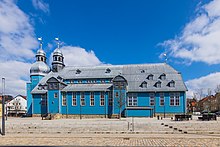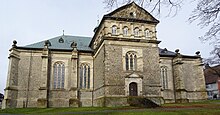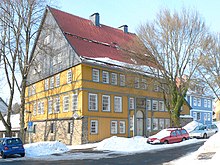Clausthal-Zellerfeld
| coat of arms | Germany map | |
|---|---|---|
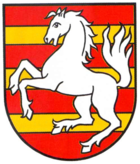
|
Coordinates: 51 ° 48 ' N , 10 ° 20' E |
|
| Basic data | ||
| State : | Lower Saxony | |
| County : | Goslar | |
| Height : | 560 m above sea level NHN | |
| Area : | 43.71 km 2 | |
| Residents: | 15,727 (Dec. 31, 2019) | |
| Population density : | 360 inhabitants per km 2 | |
| Postcodes : | 38678, 38707, 38709, 38667 | |
| Primaries : | 05323, 05320, 05328, 05329 | |
| License plate : | GS, BRL, CLZ | |
| Community key : | 03 1 53 018 | |
| NUTS : | DE916 | |
| City structure: | 2 localities , 2 districts | |
City administration address : |
At the Marktkirche 8 38678 Clausthal-Zellerfeld |
|
| Website : | ||
| Mayoress : | Britta Schweigel ( independent ) | |
| Location of the town of Clausthal-Zellerfeld in the district of Goslar | ||

Clausthal-Zellerfeld ( ) is a town in the district of Goslar in Lower Saxony , it is located in the Upper Harz at an altitude between 390 and 821 m above sea level. NHN and is the location of the Clausthal University of Technology . The city bears the title mountain and university city and the predicate climatic health resort .
geography
location
Clausthal-Zellerfeld is located on the Upper Harz plateau. Compared to most of the Harz, the area is less mountainous, but only hilly. As a result, the surrounding area is also less heavily forested and there are more meadows. Scattered in and around Clausthal-Zellerfeld are numerous ponds and watercourses of the Upper Harz water shelf .
The depression between Clausthal and Zellerfeld marks a natural “borderline”.
The Kleine Clausthal extends to the southwest .
City structure
The city consists in the center of the two districts Clausthal (in the south) and Zellerfeld (in the north), whose original urban areas are separated by the natural border of the Zellbach . Clausthal and Zellerfeld were two independent towns until 1924. Their amalgamation came about due to strong pressure from the authorities. The fact that Clausthal and Zellerfeld have not yet fully grown together can be seen from two shooting clubs and two football clubs. Until 2007, Zellerfeld and Clausthal had separate fire stations , although the voluntary fire brigade was officially merged . The Erbprinzentanne settlement to the north of it also belongs to the Zellerfeld district . On July 1, 1972, the municipality of Buntenbock , located south of Clausthal, was incorporated as the third district.
As a result of the new municipal formation on January 1, 2015, the mountain and university town of Clausthal-Zellerfeld is structured as follows:
| District | Population (January 1, 2018) |
Area in km² |
Population density in inh / km² |
|---|---|---|---|
| Clausthal-Zellerfeld | 12,761 | 33.96 | 376 |
| Clausthal | |||
| Zellerfeld (with hereditary prince fir ) | |||
| Buntenbock | (Dec 2013) 750 | ||
| Bergstadt Altenau-Schulenberg in the Upper Harz | 2,049 | 6.41 | 320 |
| Altenau | 1,758 | 4.66 | 377 |
| Peat house | (2011) 22 | ||
| Bastesiedlung | (2012) 18 | ||
| Sperberhaier dam house | |||
| Gemkenthal | |||
| Polstertal colliery house | (2012) 8 | ||
| Schuleberg in the Upper Harz | 291 | 1.75 | 166 |
| Oberschulenberg | (Jul. 2017) 12 | ||
| Mittelschulenberg | |||
| Festenburg | |||
| Mountain town of Wildemann | 786 | 3.34 | 235 |
| Spiegelthaler colliery house | |||
| Mountain and university town Clausthal-Zellerfeld | 15,596 | 43.71 | 357 |
Around 4,900 students were enrolled at the TU Clausthal in 2014/2015 .
climate
The city is valued by athletes, asthmatics and pollen allergy sufferers because of its climate and is a state-approved health resort.
The Clausthal-Zellerfelder weather is characterized by strong westerly winds, a lot of precipitation (> 1300 mm / a) and especially by long and snowy winters. The temperatures are mostly a few degrees lower than in the northern German lowlands. The TU Clausthal is jokingly referred to as the “only university with two winter semesters”.
|
Monthly average temperatures and precipitation for Clausthal-Zellerfeld
Source: DWD, 1961–1990
|
||||||||||||||||||||||||||||||||||||||||||||||||||||||||||||||||||||||||||||||||||||||||||
history
From the 9th to the end of the 19th century
In the 8th century Bonifatius is said to have built a chapel ( cell ) in today's Zellerfeld . The first settlement of the Upper Harz took place at the beginning of the 13th century with the foundation of the Benedictine monastery of St. Matthias in Cella (therefore often also called Cella monastery ), today's Zellerfeld, which probably originated from the monastery Simonis et Judae in Goslar , which was directly under the empire . The monks were already mining and in 1268 they built the middle peacock pond as a reservoir to power their mining facilities. As a result of the plague , this oldest settlement was deserted in 1348. The monastery was closed by the Pope in 1431 (in other sources: 1433) .
The second settlement took place at the beginning of the 16th century, when the Brunswick dukes showed interest in mining, namely Henry the Younger . The Brunswick part of the Upper Harz received the first mountain freedom from him in 1532 . Zellerfeld received city rights in 1529 and accepted the Reformation in 1539. In 1549 the mining office was relocated to Zellerfeld by the elder Wildemann. In 1554 Clausthal was also granted mountain freedom and flourished quickly. As early as 1600, 55 mines were in operation.
The name of Clausthal (formerly Klausthal) is probably derived from a dam for the rafting industry ( Klause ). Clausthal received the first church in 1570. The Upper Harz flourished thanks to mining. Saxon immigrants from the Erzgebirge left a lasting mark on the region, for example with their Upper German dialect (the Erzgebirge ).
In the run-up to the battle of Lutter am Barenberge , parts of the Tilly army moved into the Upper Harz to plunder and pillage. While Clausthal surrendered to the attackers without a fight, Zellerfeld, under his city governor Thomas Merten , opposed the superiority on March 19, 1626. Thomas Merten fell like most of his colleagues in this fight. In his honor, the central square in Zellerfeld in front of the St. Salvatoris Church was named Thomas-Merten-Platz.
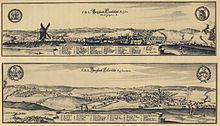
In 1672, a fire almost completely destroyed Zellerfeld. After the fire, Zellerfeld was rebuilt with a new, chessboard-like floor plan.
The deep Georg tunnel was excavated from 1777 to 1799 . The 26 km long tunnel drained the mining areas of Clausthal-Zellerfeld, Wildemann , Hahnenklee and Bad Grund .
After the Braunschweig-Wolfenbütter line died out in 1634, Zellerfeld became the seat of communion rule ( communion resin ) and fell to the Electorate of Braunschweig-Lüneburg in 1788 . From 1807 to 1813 Clausthal and Zellerfeld belonged to the Harz department . Zellerfeld then came to the Kingdom of Hanover and with it in 1866 to Prussia .
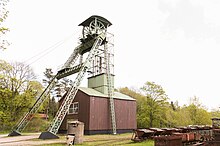
Since the beginning of the 19th century, the Ey family from Clausthal has been associated with local writers and their collections of fairy tales , sagas and prosaic stories in the dialect of the miners from the Upper Harz Mountains, as well as with associated publishers and bookshops right up until the recent history of the Lower Saxony state capital Hanover .
From 1851 to 1864 miners drove the 32 km long Ernst August tunnel from the village of Gittelde on the southern edge of the Harz Mountains. This deepest water solution tunnel in the Harz runs almost 400 m below Clausthal and drains the mining districts of the mining towns of Lautenthal , Hahnenklee, Wildemann, Clausthal-Zellerfeld and Bad Grund.
On April 18, 1854, Clausthal was badly affected by a conflagration.
In 1885 Clausthal 8871 and Zellerfeld 4407 had mostly Protestant residents, most of whom were employed either in mining and smelting or in knitting and crocheting factories.
From the 20th century
The mining towns of Clausthal and Zellerfeld, which had been independent until then, were merged in 1924. Clausthal-Zellerfeld was the district town of the Zellerfeld district until it was dissolved in 1972 .
Although there has been no mining in the city since 1930 , the city has retained its close connection with mining through the Upper Harz Mining Museum. The Bergakademie and the Oberbergamt also remind of the former mining. In the course of mining, the art of driving was invented in what is now Clausthal-Zellerfeld by Georg Ludwig Dörell and the wire rope by Julius Albert .
In the German Empire , the third largest German explosives factory, the Tanne plant , was built in the immediate vicinity on Kreisstraße 38 to Altenau . TNT was mainly produced here and it served as a filling station for bombs, mines and grenades. It was attacked on October 7, 1944 by 129 strategic bombers B-24 "Liberator" of the United States Army Air Forces with 384 tons of bombs, with around 600 of 2000 bombs hitting the plant and the surrounding camps by forced laborers. The railway systems and various buildings in the city suffered severe damage, and the station building was almost completely destroyed. 92 people were killed. A memorial at the Mittlerer Pfauenteich commemorates the victims of the slave labor in the bombing of the plant. Furthermore, in Clausthal in front of the Marktkirche and in Zellerfeld in front of the St. Salvatoris Church, the victims of the death march of the inmates of the Dora-Mittelbau concentration camp near Nordhausen at the beginning of 1945 from Osterode across the Harz are remembered. Another memorial is located on Harzhochstraße near the Hirschler pond.
Today Clausthal-Zellerfeld is best known for its Technical University. Originally a pure training facility for miners and smelters, the TU is now a university with a broad range of courses, mainly of a technical nature.
Incorporations
On July 1, 1972, the municipality of Buntenbock was incorporated. As of January 1, 2015, state law dissolved the Upper Harz municipality and its affiliated municipalities, Bergstadt Clausthal - Zellerfeld , Bergstadt Altenau , Bergstadt Wildemann and Schulenberg im Oberharz . The previously independent communities became districts that formed the new mountain and university town of Clausthal-Zellerfeld.
Population development
Population development for the territories before Jan. 1, 2015
|
|
|
|
(From 1968 as of December 31, 2018 as of January 9)
Population development for the area as of Jan. 1, 2015
| year | Residents |
|---|---|
| 2012 | 15,616 |
| 2014 | 15,857 |
| 2015 | 15,818 |
| 2016 | 15,523 |
| 2017 | 15,563 |
| 2018 | 15,888 |
| 2019 | 15,727 |
age structure
| Age structure of the population | % |
|---|---|
| 0-16 years | 10.94 |
| 17–40 years | 42.58 |
| 41–65 years | 29.15 |
| 66–75 years | 10.31 |
| over 75 years | 7.02 |
(As of September 30, 2010)
politics
City council
For the last local election on April 26, 2015, 12,332 voters in Clausthal-Zellerfeld were called to re-elect the council of the newly created mountain and university town of Clausthal-Zellerfeld as the most important and supreme municipal body . The city council consists of 32 council members. This is the specified number for a city with a population between 15,001 and 20,000.
The full-time mayor is also entitled to vote in the city council .
The local election resulted in the following:
| Parties and constituencies | Percent 2015 |
Seats 2015 |
Percent 2011 |
Seats 2011 |
|
|---|---|---|---|---|---|
| SPD | Social Democratic Party of Germany | 50.7 | 17th | 41.2 | 13 |
| CDU | Christian Democratic Union of Germany | 23.6 | 7th | 29.6 | 9 |
| FDP | Free Democratic Party | 11.2 | 4th | 5.2 | 2 |
| Green | Alliance 90 / The Greens | 6.1 | 2 | 11.9 | 4th |
| Kr.B. | Critical citizens for Clausthal-Zellerfeld | 4.9 | 1 | - | - |
| left | The left | 3.6 | 1 | - | - |
| Independent | Independent group of voters Samtgemeinde Oberharz | - | - | 12.2 | 4th |
| Mayor (until December 31, 2014 Mayor of the municipality) | 1 | 1 | |||
| total | 100 | 33 | 100 | 33 | |
| Turnout in percent | 45.85 | ||||
Note: The result of the election to the Samtgemeinderat of the Samtgemeinde Oberharz is used as a comparison value for the last local election in 2011. Until the constitution of the new city council, he also acted as interim councilor for the mountain and university town of Clausthal-Zellerfeld.
mayor
Britta Schweigel (independent) emerged as the winner of the runoff election for mayor on May 10, 2015. She was elected full-time mayor of the mountain and university town with 52.86% and prevailed against her challenger Alexander Ehrenberg (SPD), who got 47.14%.
coat of arms
Clausthal-Zellerfeld has continued its coat of arms since the dissolution of the Upper Harz municipality. In essence, it is the coat of arms of the former Zellerfeld district , which was largely located in the area of the present-day city. The coat of arms shows the Lower Saxony horse on a ground divided by red and gold seven times. In addition to the Zellerfeld coat of arms, a blue helmet with a gold-red helmet cover rests on the shield, above it a jumping horse as well as miners' mallets and irons .
Town twinning
Clausthal-Zellerfeld maintains a total of four city partnerships in Germany and abroad.
- abroad:
Clausthal-Zellerfeld also maintains a friendly cooperation with the Polish city of Wolsztyn , which is related to the earlier work of the doctor Robert Koch there in the mid-19th century.
Culture and sights
Museums
- The Upper Harz Mining Museum in Zellerfeld. This also looks after the Kaiser-Wilhelm-Schacht , the Ottiliae-Schacht and the wheel rooms of the Rosenhof mine as branch offices . All three branches of the mining museum are part of the Upper Harz Water Management World Heritage Site .
- GeoMuseum in the main building of Clausthal University of Technology
- In addition to the rock samples with the inclusions of different minerals, the collection of bizarrely deformed meteorites is worth seeing.
- Calvörsche Library
Buildings
- The market church of the Holy Spirit in Clausthal was built from oak and spruce wood in the middle of the Thirty Years' War and the roof was covered with lead. In 1642 it was consecrated at Pentecost. The Marktkirche is considered the largest preserved wooden church in Europe. A very complex renovation was completed in 2011.
- In 1997 the winged altar of the Leipzig artist Werner Tübke , who died in 2004, was consecrated in the St. Salvatoris Church in Zellerfeld, which was rebuilt after the great fire in 1683 . The organ brochure (1699–1702) was made by Arp Schnitger . Below the church are the Trebra Terraces - they were laid out at the end of the 18th century by the miner of Trebra.
- Catholic Church of St. Nicholas , built in 1961
- Oberbergamt, now the State Office for Mining, Energy and Geology , formerly also the seat of the Mining Captain
- Hotel Goldene Krone
- Bergapotheke Zellerfeld (Fratzenapotheke)
- Dietzel House, magnificent patrician house from 1673
- Fritz Süchting Institute for Mechanical Engineering
- Aula Academica of the Clausthal University of Technology
- Zellerfeld mint
- built by Duke Heinrich Julius in 1601, operated until 1788
- founded in 1617 by Duke Christian the Elder of Celle , operated until 1849
- Glückauf Hall
- A hall building in the Art Nouveau style of the 19th century, unique in southeastern Lower Saxony, with historical wall and ceiling paintings on two levels
- Clausthal-Zellerfeld town hall
- Robert Koch's birthplace
- Robert Koch's youth center
- Thomas-Merten-Platz: carillon with driving skills
- Academic swimming pool of the Clausthal University of Technology
- Upper Harz water shelf with the Upper Harz ponds , which was declared a World Heritage Site in summer 2010 .
Regular events
- Bergdankfest on the Saturday before Rose Monday
- Easter fire on Holy Saturday
- According to the Upper Harz tradition, visitors are often "blacked out" by young people / children; the faces of the visitors are smeared black with the soot from the charcoal.
- Oberharzer Bergbauernmarkt from May to October every Thursday evening in Zellerfelder Bornhardtstraße
- Oktoberfest in the Kurpark in Zellerfeld
- The total Harz yodelling competition on the first Sunday in August will take place in Altenau from 2020.
- Harz Classix Festival in autumn at 3 venues
Economy and Infrastructure
economy
The retail trade is mainly located in the main center around Adolph-Roemer-Straße in the Clausthal district. Small-scale retail can be found in the side center in the Zellerfeld district. At the beginning of 2000, an area at the former Ostbahnhof was designated as a special location for large-scale retail. Further supermarkets can be found at the northern exit of Zellerfeld. Overall, the retail trade in the former mountain town is not very well developed and is now suffering from the general decline in shops .
The development of the Clausthal University of Technology is of great importance for the mining town of Clausthal-Zellerfeld , as it increases the attractiveness and attraction of the location for innovative investments. The development of the TU Clausthal and the cooperation between local companies and science is a decisive advantage for the business location.
In addition to the usual craft businesses, there is a relatively large window factory as well as several companies spun off from the Clausthal University of Technology or CUTEC, which specialize primarily in particle measurement technology in testing technology.
Tourism is another important branch of the economy in Clausthal-Zellerfeld, but above all in its districts Altenau, Buntenbock, Schulenberg and Wildemann.
traffic
From 1877 to 1976, Innerstetalbahn trains ran from the station to Altenau and Langelsheim . Today the public transport is served by several bus lines, u. a. to Goslar, Osterode am Harz, Altenau and Sankt Andreasberg.
Public facilities
- State Office for Mining, Energy and Geology with the Lower Saxony Mountain Archive
- CUTEC , Clausthal Environmental Technology Research Center
- State Construction Management South Lower Saxony
- Local fire brigades in the districts
education
In addition to the primary and secondary school facilities, Clausthal-Zellerfeld also houses the School of Economics and Technology and the Clausthal University of Technology . The facilities of the TU are concentrated on the Feldgraben area campus as well as distributed in the Clausthal city area and on the Tannenhöhe .
Primary school:
- Clausthal primary school
- Wildemann primary school
- Elementary school Zellerfeld
Further training:
- Gymnasium Robert Koch School (open all-day school)
- Clausthal-Zellerfeld secondary and secondary school
Personalities
Honorary citizen
- 1890: Robert Koch (1843–1910), microbiologist, Nobel Prize in Medicine 1905
- 1933: Hermann Muhs (1894–1962), awarded on Heimattag on July 25, 1933
- Adolf Achenbach (1825–1903), mining captain
- Roland Boudet, former mayor of the twin town L'Aigle
- 2018: Arnd Peiffer , biathlete
sons and daughters of the town
- Justus Philipp Meyenberg (1642–1709), Protestant theologian
- Bernhard Christoph Breitkopf (1695–1777), printer and publisher
- Johann Friedrich Heintzmann (1716–1764), master builder and miner as well as architect
- Johann Friedrich Löwen (1727–1771), poet, intellectual and theater theorist
- Engelhard Benjamin Schwickert (1741–1825), publisher
- Friedrich Otto Burchard von Reden (1769–1836), mining captain
- Georg Ludwig Dörell (1793–1854), mountain master and inventor of the art of driving
- Eduard Mehlis (1796–1832), doctor and parasitologist, director of the Clausthal Mountain and Forestry School
- Heinrich Wilhelm Ferdinand Halfeld (1797–1873), engineer
- Georg Schulze (1807–1866), theologian, Germanist, author, editor and poet
- August Ey (1810–1870), educator, folklorist, local writer
- Julius Hoffmann (1812–1869), educator
- Hermann Hunaeus (1812–1893), architect
- Hermann Koch (1814–1877), secret mountain ridge and father of Robert Koch
- Theodor Müller (1816–1881), Romance and English studies
- Otto Mejer (1818–1893), German canon lawyer
- Carl Adolf Riebeck (1821–1883), industrialist and mining entrepreneur
- Gustav Drechsler (1833–1890), agricultural scientist
- Otto von Grote (1835–1891), landscape director, member of the Reichstag and Landtag
- Robert Koch (1843-1910), microbiologist
- Adolf Ey (1844–1934), high school teacher, professor, writer
- Friedrich Wilhelm Lahmeyer (1859–1907), electrical industrialist
- Erich Schaeder (1861–1936), Protestant theologian
- Otto Erich Hartleben (1864–1905), playwright, poet and narrator
- Alfred Kurz (1870–1958), Protestant pastor, superintendent
- Heinrich Fickler (1872 – after 1942), lawyer, judge at the Reichsgericht
- Max Arnim (1889–1946), classical philologist and librarian
- Robert von Förster (1913–1984), diplomat
- Carl Heinz Kurz (1920–1993), writer
- Helmut Sander (1920–1988), Lord Mayor of Goslar
- Helmut Eichmeyer (1926–2013), mining scientist and university professor
- Reinhard Roder (* 1941), soccer player, coach and official
- Dietrich Grönemeyer (* 1952), physician and author, brother of singer Herbert Grönemeyer
- Sebastian Turner (* 1966), entrepreneur
- Jörg Kunze (* 1968), handball player
- Rafed El-Masri (* 1982), swimmer
- Daniel Böhm (* 1986), biathlete
Personalities who lived or worked in the city
- Adolf Achenbach (1825–1903), mining captain
- Wilhelm August Julius Albert (1787–1846), Oberbergrat, inventor of the steel cable
- Carl Heinrich Edmund von Berg (1800–1874), forester
- Lothar Birckenbach (1876–1962), chemist
- Emil Bodenstab (1856–1924), pharmacist and local researcher
- Caroline Böhmer-Schlegel-Schelling (1763–1809), writer
- Johannes Hinrich von Borstel (* 1988), non-fiction author
- Caspar Calvör (1650-1725), theologian
- Henning Calvör (1686–1766), theologian and pedagogue, author of numerous technical publications
- Anton Paul Ludwig Carstens (1713–1768) was General Superintendent of the General Diocese of Grubenhagen and in the Harz region from 1762 to 1768 and thus “First Pastor” of the Marktkirche
- Herbert Dennert (1902–1994), Oberbergrat
- Paul Ernst (1866–1933), writer, spent his youth in Clausthal
- Wan Gang (* 1952), Chinese Minister of Science
- Herbert Grönemeyer (* 1956), musician, spent the first few months of his life on Schützenstrasse in Zellerfeld
- Jürgen Großmann (* 1952), steel entrepreneur and manager
- Johann Friedrich Ludwig Hausmann (1782-1859), mineralogist
- Guntram Hecht (1923–2018), music teacher, organist and composer
- Edmund Kolbe (1898–1983), painter
- Wolfgang Lampe (1953–2015), head of the mountain archive
- Gottfried Wilhelm Leibniz (1646–1716), universal scholar, dealt with technical problems in the Upper Harz mines from 1682–1686 and stayed frequently in Clausthal.
- Karl August von Linsingen (1803–1899), mining captain
- Thomas Merten († 1626), mountain jury and city defender of Zellerfeld in the Thirty Years War.
- Arnd Peiffer (* 1987), biathlete
- Claus Friedrich von Reden (1736–1791), mining captain
- Friedrich Adolph Roemer (1809–1869), geologist
- Dorothea Schlözer (1770–1825), the first woman to receive a doctorate in Germany, completed an extensive internship in the Clausthal mines in 1786
- Carl Schnabel (1843–1914), mining scientist and university professor
- Ekkehard Schulz (* 1941), CEO of ThyssenKrupp AG from 1999 to 2011
- Arnold Sommerfeld (1868–1951), professor at the Bergakademie Clausthal from 1897 to 1900
- Georg Philipp Telemann (1681–1767), composer
- Friedrich Wilhelm Heinrich von Trebra (1740–1819), mining captain
- Antoine-Marie Héron de Villefosse (1774–1852), commissioner for the Harz during the Napoleonic occupation
Others
Clausthal also became known for the alcohol-free Clausthal beer, which got its brand name based on the "Claus-Bräu" brewed in the Clausthal municipal brewery until the middle of the 20th century (Zellerfeld had its own Berg-Quell brewery) . The brand was sold to the Binding brewery and has since been brewed exclusively in Frankfurt am Main. In the heyday of mining, there were numerous breweries in the Upper Harz villages due to the mountain freedom , of which only one still exists in Altenau .
In the Harzreise of Heinrich Heine Clausthal (written there "Klaustal") play an important station on the Heine two pits ( " Dorothea " and " Carolina ") sailed.
The oldest evidence for coins with a rim ( coin rim ) comes from Clausthal and was minted in 1684.
Web links
- Link catalog on Clausthal-Zellerfeld at curlie.org (formerly DMOZ )
Individual evidence
- ↑ State Office for Statistics Lower Saxony, LSN-Online regional database, Table 12411: Update of the population, as of December 31, 2019 ( help ).
- ↑ a b Lower Saxony State Parliament, 16th electoral period, printed matter 16/3359: Small question "What is the significance of predicates such as" state-approved climatic health resort "especially for heath tourism and the tourism industry in Lower Saxony?" (PDF; 102 kB) . Retrieved March 23, 2011.
- ↑ Budget of the mountain and university town Clausthal-Zellerfeld 2018 (PDF file), accessed on March 4, 2018.
- ↑ Student statistics for the winter semester 2014/15. (PDF; 26 kB) Accessed December 3, 2014 .
- ↑ Where Profs greet each other with Glückauf in Die Zeit of July 16, 1993
- ^ H. Speckter, report of the local planning Clausthal-Zellerfeld
- ↑ Local family database Schwiegershausen (Osterode am Harz) / Family report Johann Christian Friedrich EY * in Clausthal on genealogy .net , [ stated there without individual references ] last accessed on January 15, 2013
- ↑ Compare, for example, this GND number of the German National Library
- ^ Heinrich Pröhle: Schulze, Georg . In: Allgemeine Deutsche Biographie (ADB). Volume 32, Duncker & Humblot, Leipzig 1891, p. 775 f.
- ^ Hugo Thielen : EY, (2) Ludwig. In: Dirk Böttcher , Klaus Mlynek, Waldemar R. Röhrbein, Hugo Thielen: Hannoversches Biographisches Lexikon . From the beginning to the present. Schlütersche, Hannover 2002, ISBN 3-87706-706-9 , p. 112f. u.ö .; online through google books
- ↑ In detail: Matthias Blazek: Das Löschwesen in the area of the former Principality of Lüneburg from the beginnings to 1900. Adelheidsdorf 2006, p. 210.
- ↑ Evert Heusinkveld: The Innerstetal train Langelsheim - Altenau 39. Nordhorn 2007
- ^ Federal Statistical Office (ed.): Historical municipality directory for the Federal Republic of Germany. Name, border and key number changes in municipalities, counties and administrative districts from May 27, 1970 to December 31, 1982 . W. Kohlhammer, Stuttgart / Mainz 1983, ISBN 3-17-003263-1 , p. 218 .
- ↑ Lower Saxony State Chancellery (Ed.): Law on the rebuilding of the mountain and university town of Clausthal-Zellerfeld, district of Goslar . Lower Saxony Law and Ordinance Gazette (Nds. GVBl.). No. 21/2014 . Hanover October 22, 2014, p. 299 ( digitized version [PDF; 1,2 MB ; accessed on November 9, 2019] p. 13).
- ↑ a b Budget of the mountain and university town Clausthal-Zellerfeld 2018 (PDF file), accessed on March 4, 2018.
- ↑ Result of the election to the city council of the mountain and university town Clausthal-Zellerfeld (PDF document)
- ^ Goslarsche Zeitung (Tuesday, April 28, 2015, No. 98/232), p. 26
- ^ Lower Saxony Municipal Constitutional Law (NKomVG) in the version of December 17, 2010; Section 46 - Number of MPs , accessed on May 2, 2015.
- ↑ a b www.clausthal-zellerfeld.de: City partnerships on www.clausthal-zellerfeld.de .
- ↑ https://www.sueddeutsche.de/leben/jodler-harz-1.4552349 .
- ↑ Goslarsche newspaper: Harz yodeling contest moves to Altenau to
- ^ Hermann Klingsöhr: Heimatthok 1933 . In: General Harz Mountain Calendar . tape 1934 . Piepersche Druckerei und Verlag GmbH, Clausthal-Zellerfeld 1933, p. 36-39 .
- ↑ Helga Meier-Cortés: A sign of friendship and reconciliation - Clausthal-Zellerfeld awarded the former mayor of L'Aigle, Roland Boudet, honorary citizenship in: General Harz-Berg-Calendar for 1990 , pp. 29–32
- ↑ Honorary citizen for gold medalist Arnd Peiffer. Süddeutsche Zeitung , April 18, 2018, accessed on August 26, 2020 .
- ^ Heinrich Pröhle: Schulze, Georg . In: Allgemeine Deutsche Biographie (ADB). Volume 32, Duncker & Humblot, Leipzig 1891, p. 775 f.
- ↑ see the GND number of the German National Library and the information from Adolf Ey
- ↑ Jürgen Gottschalk: Technical suggestions for improvement in the Upper Harz mining industry . In: Erwin Stein , Albert Heinekamp (ed.): Gottfried Wilhelm Leibniz - The work of the great philosopher and universal scholar as mathematician, physicist, technician . Gottfried Wilhelm Leibniz Society, Hanover 1990, pp. 62–71. ISBN 3-9800978-4-6 .
- ^ Heinrich Heine: The Harz journey . Reclam, Stuttgart 2017, p. 21-23 .











